The credit of using the unmanned platform for the first time goes to Austria, when in1849 it attacked the Italian city of Venice using unmanned balloons loaded with explosives1. Surely, the Austrian warriors could have never imagined that this humble beginning of theirs would explode into such a revolution one day, that it would dwarf everything else in the aerial warfare domain. The ‘unmanned revolution’ is upon us for decades now!
Starting from very humble beginnings of little unmanned platforms capable of looking ‘over the hill’ or ‘round the corner’, the combat potential of unmanned vehicles has soared exponentially over time to earn the distinction of being called the ‘dull’, ‘dirty’ and ‘dangerous’. Armed to the teeth, having phenomenal endurances, capable of all-weather and all-terrain operations, no crew fatigue, no lack of motivation, no loss of pilot life…. the unmanned platforms have risen like a sphinx.
As the years rolled, two specific battle functions branched out of the unmanned platforms. One was the teaming of the manned and the unmanned in joint missions. Here the unmanned platforms stood shoulder-to-shoulder with the combat pilot, ‘looking around’ to produce a paradigm enhancement in his situational awareness and increasing his strike potential by many notches in taking on targets, either as assigned or suo moto (latter attracting much ethical criticism- machine over man!)
The other function emerged as the artificial intelligence (AI) became more and more robust so as to be able to weaponise combat platforms. What gradually emerged were the ‘drone swarms’ where hundreds of small unmanned machines were programmed to take on a target, much like the deadly swarm of locust that can menacingly destroy hundreds and thousands square yards of standing crop in a matter of minutes… beyond the control of humans or their machines.
Ironically, it was only a few days back, when the world saw the heart-shaking headlines announcing alarmingly that ‘locust swarms, some three times the size of New York city are eating their way across two Continents, threating famine in Africa, Middle East and the Indian subcontinent2.
This article presents the ‘drone swarm’ scene both at the world stage, as well as, at the Indian doorstep.
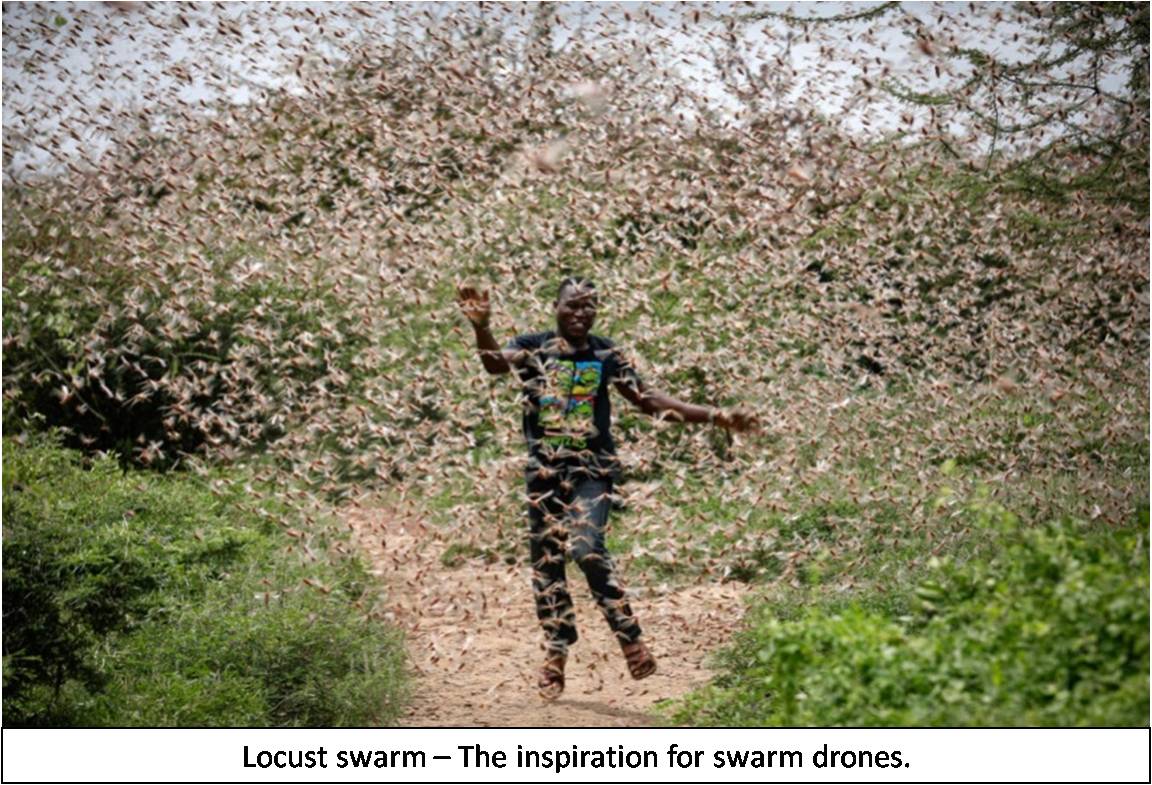
What is a SWARM?
SWARM is an acronym which stands for Smart Warfighting Array of Reconfigurable Modules. In the language of the Unmanned Aerial Systems (UAS), a swarm would refer to a body of a varying number of small autonomous vehicles which are gridded together to act as one whole (much like the locust swarm). Technology today allows such swarms to fly togetherbased on their own pre-fed intelligence and without any dependence on the traditional ground control station.
A Possible SWARM Task Sheet
This body can be tailor made to produce the end results which could take any of the following forms and more:-
- Positioned over the area of interest and so programmed as to deliver uninterrupted and continuous information about the designated area. This role in UAS parlance is called Gorgon Stare (Gorgons were three sisters in ancient Greek mythology whose gaze was so ‘grim dreadful and unblinking’ that itcould turn a person into a stone!).
Actually each sensor on board the UAS in the swarm will produce its own output. Technology allows the fusion of inputs from multiple sensors into one comprehensive picture shown to the user who has every control over shaping the output, with respect to sensor pan/tilt, range, field of view, altitude, resolution, selective area –zoom etc.
- UASs gridded as swarms actually rely upon each other as migrating birds. They complement one another in group and adhere to the body of rules that is built into them through tools of AI. These rules can be so configured as to produce different shades and levels of intelligence in the vehicles allowing them to perform many different tasks as desired by the user . Some of these could include:-
- Navigate quietly and precisely through restricted spaces (doors windows, bottlenecks, galleries, difficult terrain etc.), ‘peep through’, collect and send user-demanded information in real-time on audio/video/data etc.
- Carry out a ‘keep watch’ role duly placed at a user-selected location and report continuously. In this role, the machines could be fed with the ‘default threshold’ of data related to the area under watch. Any gradual/sudden increase in activity can be picked up and analysed by the user for what it is worth.
- Select targets based on pre-fed information and fire on them as programmed or fire at opportunity targets on user command.
- The machines in the swarm, based on the intelligence built into themdevelop a degree of survivability as individual vehicles recognise their identity as a ‘body of gridded vehicles’. In such a grid if a vehicle(s) gets knocked down or cannot keep station due to some malfunction, the grid quickly re-adjusts and re-configures respective positions so to fill the gap created. Much like a body of warriors that continues to advance/fight even if a soldier(s) gets knocked down from the group.
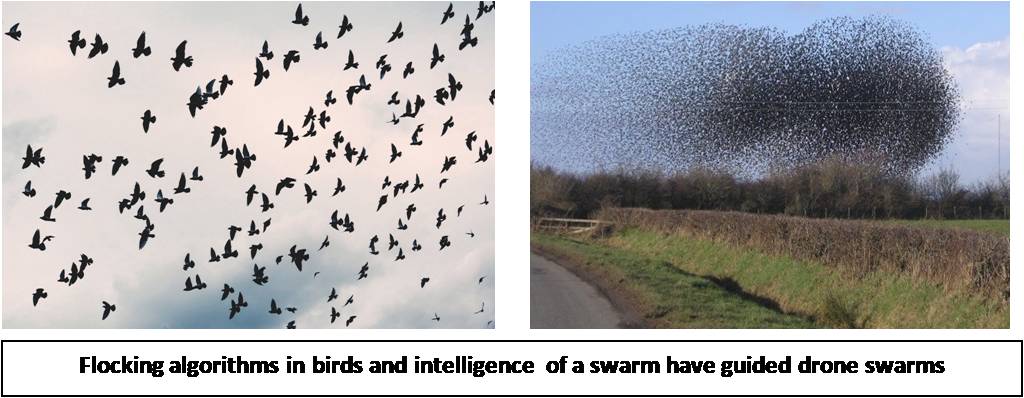
Swarms in Action-World Scene
The First Swarm attack in History Happens…
The date of 05 Jan 2018 is a historic in the saga of swarm drone warfare, as that marks the date when the first recorded and organised swarm drone attack took place. It was reported that on this day a group of 13 GPS guided drones attacked the Russian air base at Khemmiem and Tartus naval facility in West Syria. Out of the thirteen drones that formed the strike package, ten attacked the air base while the other three attacked the naval base.3
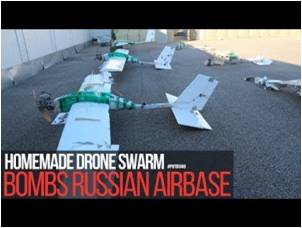
Russia being a strong air defence power claimed that seven of these drones were blown up with anti-aircraft missile systems while the other six were soft-killed by cyberwarfare unit4. Out of latter, three of them exploded on landing, while three were retrieved intact5.
The inspection of the intact drones revealed that these were rudimentary in construction; the home-made, ‘Do-it-Yourself’ (DIY) variety. Powered by a single propeller, the drones had no landing wheels and were mostly made of wood and plastic.
The bigger questions in the Russian swarm attack
It is not of much relevance whether the Russians were able to beat the drone attack or otherwise, what is of relevance is the following:-
- A new capability to wage aerial warfare which actually was simmering to unfold for some time, actually took shape on the night of 5/6 Jan 2018. The unmanned revolution just moved up another notch in lethality.
- One should not be swayed by thefact that the machines were rudimentary and DIY variety etc. These were in fact ‘advanced machines’. Sample the following6:-
- Each machine had a control package and a fuel tank on board.
- Each had a separate warhead which was composed of improvised explosives ‘packed professionally’ in the assigned coordinates.
- The machines displayed excellent remote control capability of dropping the warhead precisely, on user command.
- The GPS navigation capability of the explosives was technically very sound and of a high order. The Russians analysis showed that these were launched from a range in excess of 50 kms and guided (autopilot-flown) precisely to the targets.
- The analysis also revealed that the drones probably had an attack range more than 100 Kms. This deduction was possible as the Russians were able to identify the launch site as Muwazarra in the Southern Idlib province of Syria; which is that far.
- The programming andcontrol of GPS guided vehicles to fly around 50 Km and drop the warhead precisely, is work of advanced engineering involving the use of satellite communication.
- Probably the remote weapon delivery technique relied on precise instrumentation such as pressure transducers and altitude-controlled servo actuators.
It is no wonder therefore, that the Russians called the drones ‘highly advanced machines.’
Anonymity??
- While the Russians blamed the Syrian rebels who are active in the area of Idlib with full backing from Turkey for the attack while some other quarters saw the hand of US intelligence, the identity of the attackers essentially remained a mystery. Following are the implications of this fact:-
- If the Russian claim is to be accepted, it marked the ominous beginning of the dark era when a new but precise weapon of destruction reaches the hands of terrorists and other non-state actors.
- It also proved the great advantage of anonymitythat such attacks offer, wherein, a bunch of non-state actors can cause disproportionate damage and remain hidden. It is another point that in this case a lesser known terrorist group‘Free Alawite Movement’ claimed the responsibility for attack.
- The Russians launched their top of the line Pantzir S missiles (unit cost of the system - 13.15 - 14.67 million USD) to kill the seemingly crude drones proving the point that how a disproportionate cost can be slapped on the defender by such cheap machines as was the set of 13 drones.
Another Swarm attack
5 Jan 2018 was not destined to remain a‘never gain’ event. On 14 Sep 2019 two Saudi oil production facilities in Abqaiq and Khurais operated by the state-run oil production company Aramco, were hit by a swarm drone strike disrupting and stalling some 5.7 million barrels of crude oil.
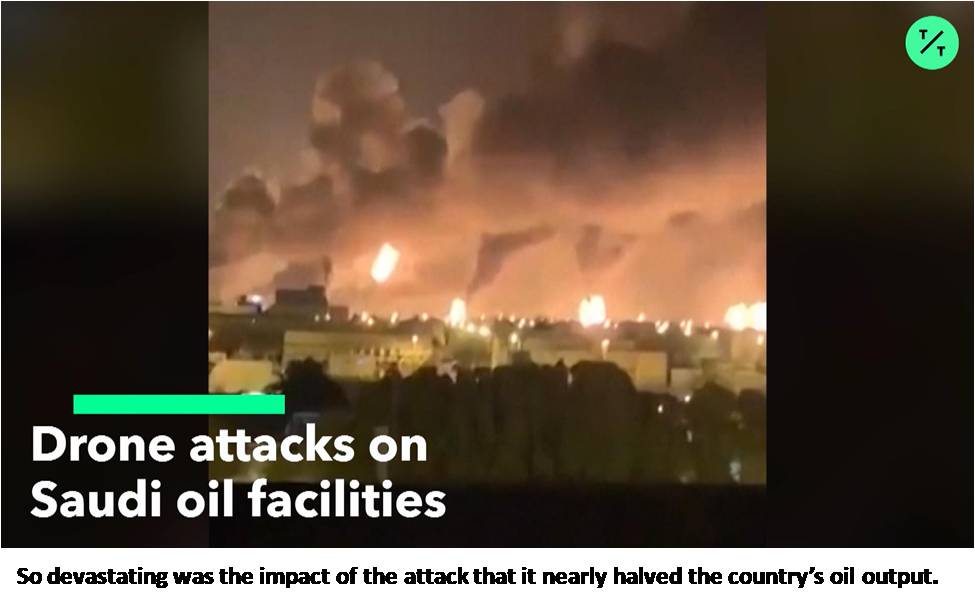
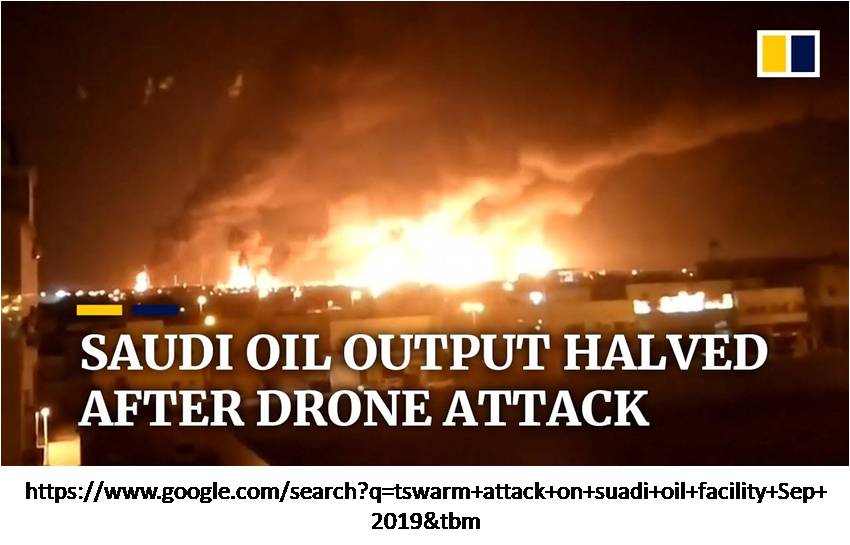
The assessment was again the same… swarming drones in the hands of non-state actors precisely navigated and controlled could cause disproportionate damage to their intended targets. This came to be corroborated as the Yemen based Houthi movement, which is waging a proxy war against the Saudi Government claimed the responsibility, stating that they had directed some ‘ten weaponised robots’ to the oil facility7.
According to a report published by the United Nations Security Council, Houthis are known to be using a drone called UAV-X which is also nicknamed ‘suicide’ or ‘Kamikaze’ drone owing to its feature of getting destroyed in attack8.
AI Powering Autonomous Warfare
In May 2018 an online architecture magazine named Dezeen premiered an 18 minute documentary tilted Elevation. While this documentary essentially showed how the drones will change cities by revolutionising travel, deliveries, architecture and more by expanding human consciousness itself, it also warned that drones are potentially as ‘disruptive’ as the ‘internet’9.

Swarm drones that represent the above ‘disruptive potential’ as ‘destructive potential’ are becoming dangerously strong on the enabling wings of technology.Some experts have called it ‘weaponsing of AI’. Some salient points are enumerated:-
- There are many advantages of using swarm drones as tools of warfare:-
- It is a downright low-cost option to wage war as compared to the sky-rocketing costs of aircrafts, missiles guns etc.
- Unlike any other weapons of war, save the high-cost intelligent ammunition (like loitering ammunition etc.), swarm drones have a tremendous edge in having a ‘mind of their own’. Once programmed by the enabling tools of AI, these miniature warriors are capable of taking decisions, take default actions where no orders exist or where there is ambiguity and possess the capability to conduct ‘intelligent autonomous warfare’.
- Owing to their sheer numbers, they can simply overwhelm any capability of the defenders infielding kinetic countermeasures. Afterall, every sensor has a finite capability to track a certain number of targets and every air defence system has a finite target handling capability. What if that gets beaten by a count of hundred or even thousand! Conventional systems will just collapse, or may be, they will be able to take on a few out of the hundreds of miniature warriors.
- Look at the Russian example. Out of just 13 drones, the mighty Pantzir-S could take out only seven. Suppose the attackers were 100 or say 500?
- Researchers are getting inspired by the ‘motivation’, ‘inspiration’‘intellect’ and ‘resolve’ (each word intended) of birds and insects to go about their task resolutely and decisively.
For instance, the lowly ant will ultimately succeed in climbing the wall even if it drops a hundred times, or will succeed in carrying a load many times its weight even if it takes a hundred attempts. The motivated termite will continue to build its colony without central control. The bees in the hive will go on doing their assigned job without the queen bee needing to command every bee every time.
The researchers are trying to replicate the above behaviour in swarm drones. The day is not far when the AI will actually empower the swarm to do the following:- 10
- Show a high degree of ‘collective intelligence’.
- Exhibit a degree of ‘resolve’and ‘inspiration’ to go about with the task assigned.
- Capability of each member of the swarm to act autonomously (but to a plan) without instructions from central control.
- Capability to quickly adapt and respond to unexpected changes.
- Capability to disseminate information in huge groups and colonies almost instantly.
- Capability to operate on multiple frequencies to resist jamming yet, remain a part of one homogenous group.
- Capability of ‘group think’ to shoot down multiple threats simultaneously, quicker than a human brain can process. Something like 100 fielders with 100 balls with each fielder precisely shooting his own ball in the goal assigned to him/chosen by him!
- Capability to remember the path which they have taken to return back in default mode. It is said that ants use pheromones to remember the path they take from their nest to food. Based on this principle, a company in Switzerland (M/s Ecole) way back in 2018 developed an algorithm called SWAVNET (Swarming Micro Air Vehicle Network) that allows a body of swarming drones to mimic the above behaviour.
The above list is only limited by imagination. Not far in the horizon lurks the ultimate danger of the weaponisation of AI – ushering an era of autonomous systems that can kill without any human intervention. That public pressure and ethical brigades will not let them release the genie out of the bottle; that is the hope today.The UN Secretary General, Antonio Guterres echoed these sentiments when he said that the prospect of machine with discretion and power to take human life is ‘morally repugnant’11
Swarming Drones Getting Battle-Ready
Front runner countries around the world are realising the battlefield potential of swarming drones. Some random information is presented to drive home the point:-
- As of Mar 2019, there was a report in the media quoting British Defence Secretary as saying that ‘swarm squadrons’ will be deployed by the British armed forces in the coming years12.
- Around the same time as above, it was reported that the US is working on a swarm drone programme dubbed as ‘Gremlins’ which involved micro drones designed to be dropped from planes to perform reconnaissance over vast areas. Also there are reports of front-line research in US having developed the capability of building drone intelligenceto adapt and respond to unexpected threats.
- As late as in Feb 2020, there were reports of China having developed helicopter drones capable of carrying a variety of munitions like machine guns, grenade launchers and mortar shells which can move as a swarm finding their way to the designated target, carrying out engagement in an autonomous fashion and return to base without the human operator having toexpose himself/herself to the frontline13.
- Earlier in Jan 2018, it was reported that China has tested a swarm of 1000 drones. For a full nine minutes, a body of 1180 drones sparkled in the sky in formation discipline marking the close of global Fortune Forum in Guangzhou on 07 Dec 201714.
It is well understood that while controlling any number of display drones inany organised demonstration is essentially a coding and a software game, preparing hundreds of machines carrying variety of arms and munitions to take off for a far off destination and execute multiple tasksprecisely and autonomously is a highly technical feat of weaponising AI. Something that can produce collective intelligence, hive behaviour, decision-making capability and more; China is close to this target
.
- US is reported to be working on the offensive uses of drone swarms for many years now. In 2018, a capability was successfully tested whereby swarms of could press ahead with their mission even if the communication with their human controllers was disrupted. This was referred to as Collaborative Behaviour in Denied Environments (CODE).
Also, on building offensive capabilities human managers are using the tools of virtual reality to control the formations of hundreds of drones. The acronym, given to this activity in US is ‘Offensive Swarm- Enabled Tactics (OFFSET).
- Swarm drone capability of Pakistan? Suffice to say that in times of need, China will not be found wanting. Also of relevance are two facts. One, Pakistan is currently at a stage when its home grown unmanned combat aerial vehicle called Burraq has matured for over four years now. Two, 48 high-end Wing Loong II UCAVs capable of teaming with the manned platforms is under sale to Pakistan15. When India was firming up on S-400, there were unconfirmed and uncorroborated reports of Pakistan trying to seek swarm drone support from China16.
- In Nov last year there was much talk of the Russian Flock 93 concept. This concept, reportedly developed by the Zhukovsky Air Force Academy envisaged launching more than 100 drones each carrying a 5.5 pound warhead. This drone was to be a Vertical Take Off and Landing (VTOL) flying wing type of drone (probably Kalashnikov ZALA -KYB drone). Definite operationalisation of this capability has not been reported in the mediabut where is the doubt that such a capability (and more) is well within Putin’s Russia’s technological might17.
- According to the reports just coming in, Russian attack drones (Okothnik and Altius) will be operating with manned combat platforms like SU 57 in the MUM-T mode taking on the targets as designated by operating a totally autonomous mode. It can also detect best approach routes avoiding adversary’s air defences thus saving manned platforms.
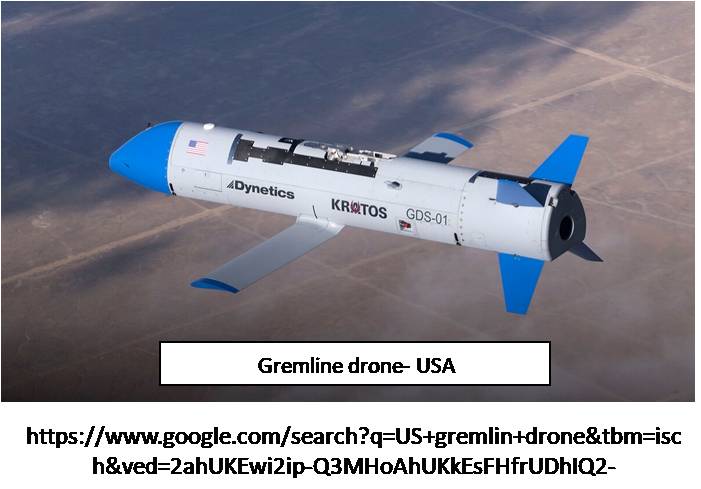
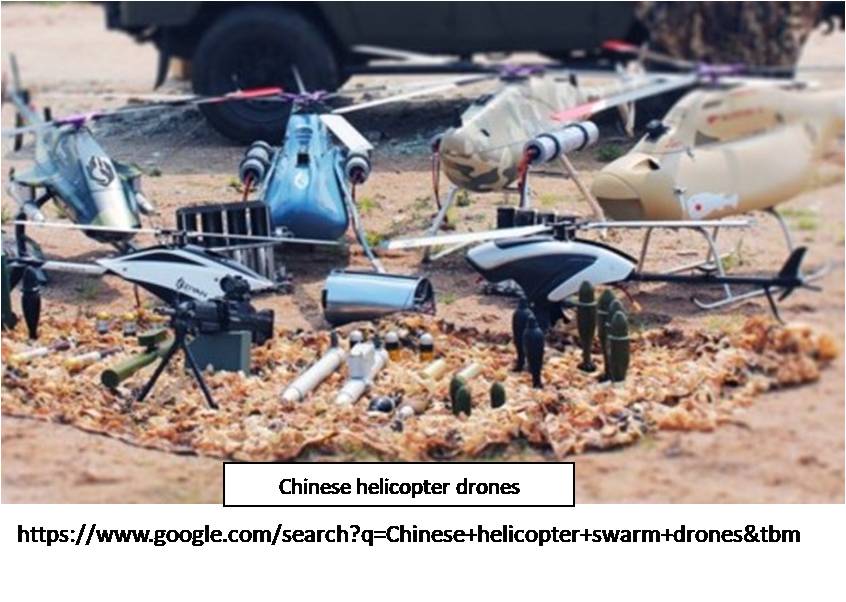


Swarm Drone Capability of India
Where is India in swarm drone capability? The answer is ‘up and about’. A lot of work is happening in India in swarm drone as well as related fields. Salient points are enumerated18192021.
- The State-run Hindustan Aeronautics Limited (HAL) has joined up with a Bengaluru based start-up New Space Research and Technologies, a company which designs and develops ‘Persistence Drones (implying long endurance drones) for the purpose of Earth observation and communications.
- The above tie up is working on three Projects:-
- Development of a robotic wingman unmanned drone.
- Development of an ultra-high altitude drone.
- The system consists of small drones 1-2 meters long and capable of carrying1.5 tonnes of explosives. The drones have foldable wings.
- Due to their small size, some 30-40 of them could be carried on board a SU 30 MKI platform or on an upgraded Jaguar (Jaguar Max).
- The drones have stealthy features. The on-board batteries whichlast a couple of hours can propel the drone upto 100 km/h.
- When in flight, the drones are connected to the mother aircraft through infrared and electro-optical two-way data secured data link.
- Once deployed by the manned aircraft, the drones scout for targets of opportunity. These could be any type of designated vulnerable areas, SAM sites and so on.
- Once the target is acquired, it is destroyed by the drones in the Kamikaze mode of attack by achieving a catastrophic collision with the same.
- As regards Robotic Wingman, it is an unmanned drone which is designed to accompany a manned platform in a Manned and Unmanned Teaming (MUM-T) mode also called the Combat Air Teaming System or CATS for short. Wingman will be about half the size of a fighter aircraft.
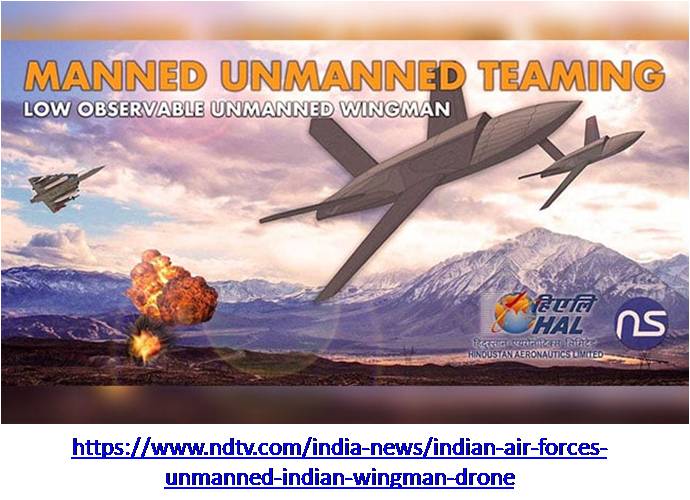
In the CATS mode three to four such drones could be flying about a 100 kms ahead of the manned systems providing the mother aircraft with battlefield situational data. The Wingman will have its own radar and sensor and will carry a Precision Guided Munition (PGM) which could be a laser guided bomb or an air-to-surface missile (future versions could also carry an air-to-air missile). A two-way secure data link like that of ALPHA-S will also empower the connect between the Wingman and mother aircraft.
- The ultra-high altitude drone will have a capability of flying at some 65000 ft and will have an endurance of not less than three weeks. It was reported that at this altitude, it will be able to obtain real time information of areas deep inside Chinese territory even by keeping on own side of the border.
- Development of air launched swarm drone going by the name of ALFA-S (Air Launched Flexible Asset - Swarm).
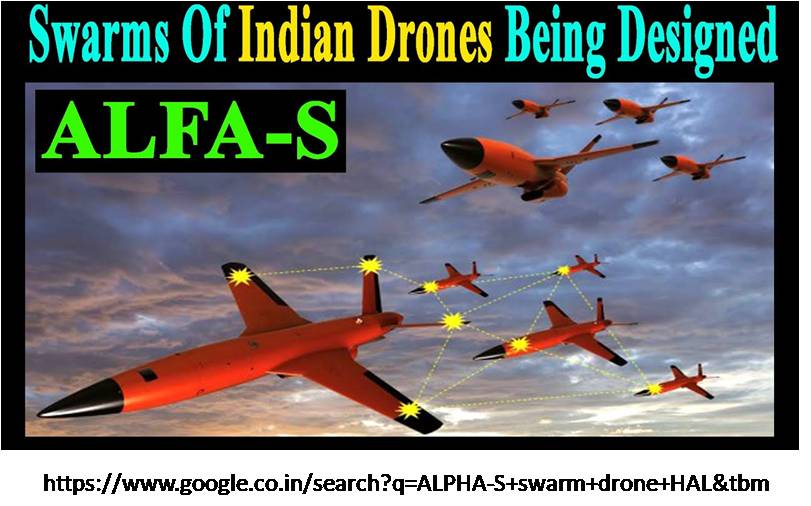
3. Following details of ALPHA-S are relevant:-
So that is the happening world of swarm drones where the encouraging fact is, that India is keeping pace with the front-runners.
On the flip side, swarm drones are a huge, huge threat far outside the capability of conventional kinetics air defence systems. How the defenders are gearing up to take on this challenge?
That is another world by itself which will require a full article space. May be the next one!
End notes
- “The history of drones, “ atwww.droneenthusiast.com. Accessed on 23 Mar 2020
- “Locus swarms, some 3 times the size of New York City are eating their way across two Continents,” at wwwinsideclimatenews.org. Accessed on 24 Mar 2020
- “Swarm drone attack in Syria points to a new kind of warfare,” at www.globalriskinsights.com.Accessed on 27 Mar 2020
- “Russia says January 5th attack on its Syrian Airbase was by a swarm of drones,” at www.thedrive.com.Accessed on 27 Mar 2020.
- “Swarm of armed DIY drones attack Russian military base in Syria,” at www.cnbc.com.Accessed on 27 Mar 2020
- “Russia claims it repelled home-grown drone swarm attack in Syria,” at www. theregister.co.uk. Accessed on 27 Mar 2020
- “Massive swarm drone strike on Saudi oil facility demonstrates destructive potential of autonomous weapons,” at www.dezeen.com Accessed on 27 Mar 2020
- “United NationsSecurity Council Report No S/2019/83,” at www.securitycouncilreport.org. Accessed on 27 Mar 2020
- “Elevation-how drones will change cities,” at www.dezeen.com.Accessed on 27 Mar 2020
- “How swarming drones will change warfare,” at www.bbc.com Accessed on 28 Mar 2020.
- “Are drone swarms the future of aerial warfare,” at www.the guardian.com. Accessed on 28 Mar 2020.
- 10 ibid.Accessed on 28 Mar 2020.
- “China’s swarm of Rocket drones could be a big problem for the US military,” at www.nationalinterest.org.Accessed on 28 Mar 2020.
- “China is making 1,000 UAV drone swarms now,” at www.popsci.com. Accessed on 28 Mar 2020.
- “All about Wing Loong II :Pakistan’s new Drone from China,” at www.economictimes.indiatimes.com. Accessed on 28 Mar 2020.
- “the future of droneswarm technology in Pakistan and China,” at www.youtube. Accessed on 28 Mar 2020.
- ‘Flock 93is Russia’s dream of a 100-strong drone swarm for war, “ atwww.c4isrnet.com. Accessed on 28 Mar 2020.
- “India to develop air-launched swarm dronesystemsstealthy AI enabled combat drones,” at www.defenseworld.net. Accessed on 29 Mar 2020.
- “Swarms of Indian drones being designed to take out targets like Balakot,” at www.ndtv.com.Accessed on 29 Mar 2020.
- “Airforce’s unmanned Indian Wingman drone could redefine air warfare,”at www.ndtv.com .Accessed on 29 Mar 2020.
- “Drone designed by Indian start up could track Chinese military moves,” at www.ndtv.com.Accessed on 29 Mar 2020.
(The paper is the author’s individual scholastic articulation. The author certifies that the article/paper is original in content, unpublished and it has not been submitted for publication/web upload elsewhere, and that the facts and figures quoted are duly referenced, as needed, and are believed to be correct). (The paper does not necessarily represent the organisational stance... More >>









Post new comment